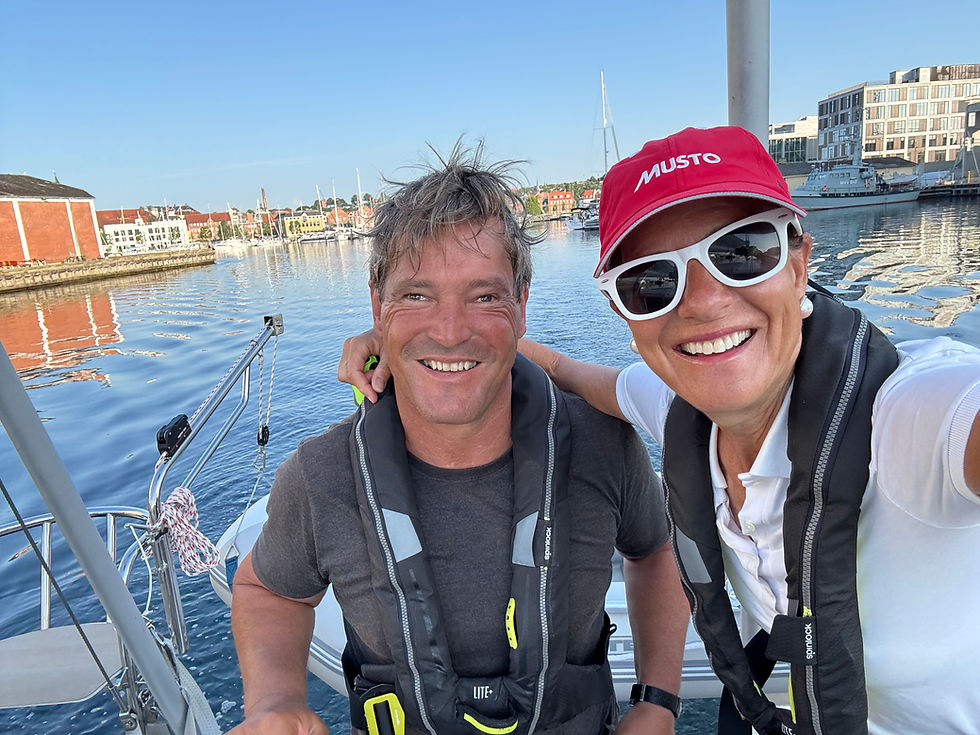North Sea
- Beth Solomon

- Jun 25, 2024
- 3 min read
Day 7, Nieuwpoort, Belgium. The alarm went off at six. Our ring tone is “Scavenger” in the iPhone, an upbeat tune. Within 30 minutes we whisked our lines off the dock and were purring out of the marina toward the sea. Despite a stiff breeze, Gero undocked Star Mist smoothly.

As sailors know, the seemingly simple docking and undocking can be suddenly tricky
because the spaces are so narrow, the water is so shallow, and you can’t just “stop the car.” The boat has to be moving for the rudder to steer it. Wind can be stronger than your engine, sabotaging your turns.
Fortunately, Gero has mastered the hard parts in our first few days on Star Mist. My job is to jump onto the deck with the appropriate lines and tie the appropriate knots, or the reverse when we’re headed out to sea. During these maneuvers, I did a dive-roll once onto the planks, and have launched two pairs of sunglasses into the murky water. I’m a rookie - I know it! But it’s getting easier.

As we sailed out of Nieuwpoort, I stowed all the fenders, bundling all our docking lines into the lockers so they wouldn’t shake loose from the side rails and disappear in the swell. Dark clouds hung ominously low in the sky. Wasn’t the weather forecast supposed to be good? We hoisted our mainsail for the first time since Dover. Then the genoa. All good! Star Mist was rolling over the five-foot waves. The mainsail and halyard were fine. Relief.

As we headed out to deeper water in a broad reach, the swell started to throw the sails in different directions. Just one hour into our planed journey to the Netherlands, my tummy was objecting. We were navigating both with Navionics and an app called Savvy Navvy. John Neal told us to navigate with two different systems simultaneously, because they can differ. Better to have a back-up, and a second opinion.Who knew that the North Sea was so shallow, and filled with sand banks? Encyclopedia Brittanica says, “The North Sea is one of the most dangerous seas in the world. Because the sea is mostly shallow, the currents are strong and often pull in different directions.”
As we sailed northeast in 11-14 meter depths, one app told us that an approaching shallow area was passable, but all of a sudden our depth gauge dropped to 1.7 meters. Gero yanked the wheel to port to avoid grounding us. The boat spun 300° and the boom whipped around into a strong jibe. What was happening?

The truth about sailing with two people in these often violent waters is that everyone has to be paying attention and there’s very little room for error. Following this serpentine path through a narrow channel through the sandbanks was like riding a bicycle on a twisty mountain cliff. As the boat wiggled and wobbled, tossing our tummies like salt shakers, we thought, "Is this necessary?" We're not pros. We're not purists. We decided to tighten the boom, furl the genoa, and start the engine.

Our wonderful Volvo Penta D2-40 jumped on instantly, whirring along quietly as we reached our cruising pace of 2000 rpms. We turned on the autopilot, made milky English breakfast tea, and munched on comforting shortbread while the clouds blew away. Exhale. Gero, who had been at the helm since we started, stretched out in the deck salon and took a nap. We were four hours into our first overnight passage from Belgium to the island of Texel, off the northwest coast of the Netherlands. Only 23 hours to go



Comments